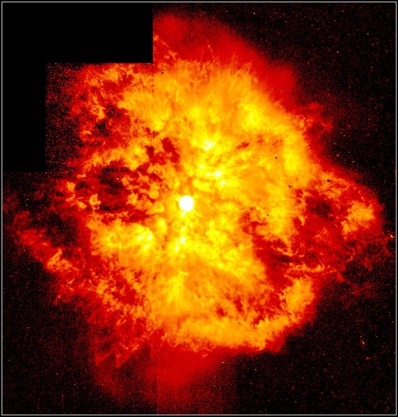



|

|

Wolf-Rayet binary a
dust-forming factory
by Mehmet Alpaslan
for ASTRONOMY NOW
Posted: 07 June 2011


A team of scientists at the Université de Montréal and the Centre de Recherche en Astrophysique du Québec have used the Canadian microsatellite MOST (Microvariability & Oscillations of Stars) to improve our understanding of dust forming processes around massive, dying stars known as Wolf-Rayet stars.
Despite the abundance of interstellar dust in space, the processes that lead to its formation are still poorly understood. A possible theory is that in the case of carbon-based dust, it is formed around stars that are fusing helium into carbon atoms. Current models predict that dust should form in regions around stars, in gas with high pressure but low temperature. These models, however, are contradicted by observations of very hot stars that actively produce dust (such as carbon-rich W-R stars). This research conducted by Alexandre David-Uraz, under the supervision of Anthony Moffat, sheds some much-needed light on the mystery.

A Hubble Space Telescope image of the nebula M1-67 around the Wolf-Rayet star WR 124. Image: Yves Grosdidier (University of Montreal and Observatoire de Strasbourg), Anthony Moffat (Universitie de Montreal), Gilles Joncas (Universite Laval), Agnes Acker (Observatoire de Strasbourg), and NASA.
Using the MOST satellite, the team observed a bound pair of stars orbiting each other in the Serpentis constellation. The binary system, known as CV Ser, consists of a Wolf-Rayet star and a hot, massive, main-sequence O-type star. Wolf-Rayet stars, named after the two Parisian astronomers Charles Wolf and Georges Rayet who discovered them in 1867, are massive stars that have reached the final stages of their lifetimes and have used up all the hydrogen fuel in their cores. Unable to sustain their current dimensions without hydrogen fusion powering them, these massive stars shrink until they reach pressures and temperatures large enough to fuse helium; at this point they begin to emit much more energetic photons. WR stars are characterised by strong stellar winds emanating from their surfaces, winds that often carry carbon atoms – the by-product of helium fusion – that later grow into dust grains. Astronomers are able to observe this phenomenon, but the creation of dust in such hot stars directly contradicts theoretical models.
David-Uraz argues, “the dust formation may originate in the region where the winds of both binary companions collide, since this shock results in a zone of enhanced density, and as the matter flows along the shock, it is subjected to radiative cooling, giving what could possibly be the ideal conditions of density and temperature for this kind of process. Therefore, if we manage to observe and constrain the parameters of dust events, we might take a step forward in understanding this most intriguing phenomenon.”
The team used the MOST satellite to observe the system as the O-type companion star was being partially eclipsed by the wind of the WR star, in 2009 and again in 2010. They noticed that the dip in light they saw in 2009, caused by the eclipse of the O star, changed its depth by 70 percent over one 29-day orbital cycle, an unprecedented phenomenon that can only be explained by the mass-loss rate of the WR star increasing by the same amount. In other words, the WR star is expelling more matter from its surface per second.
“When we first got to see the 2009 MOST light curve, we were of course quite puzzled," says David-Uraz. “However, once we contemplated the implications of such a depth change on the structure of the WR wind, knowing the history of this system, we were very enthusiastic about the novelty of these observations – being able to view such a drastic change of the wind parameters in such a short time.”
These observations promise to be the first in a series of exciting discoveries about the CV Serpentis binary system. “While the photometry of CV Serpentis provides us with very exciting and promising data, we also have parallel spectroscopy which will help us confirm our current results and further our investigation of this remarkable system. Of course, many questions will remain following this study and hopefully CV Serpentis will finally get the attention that it deserves,” concludes David-Uraz.
|

|

|

|
|



